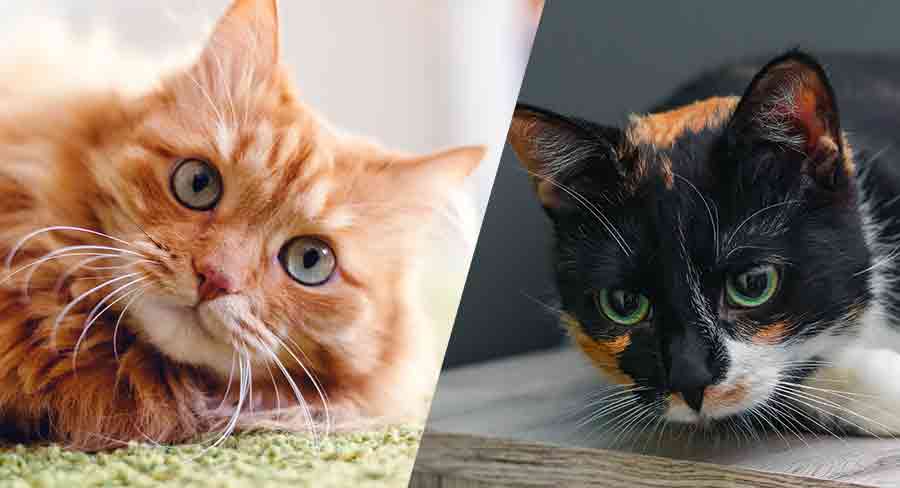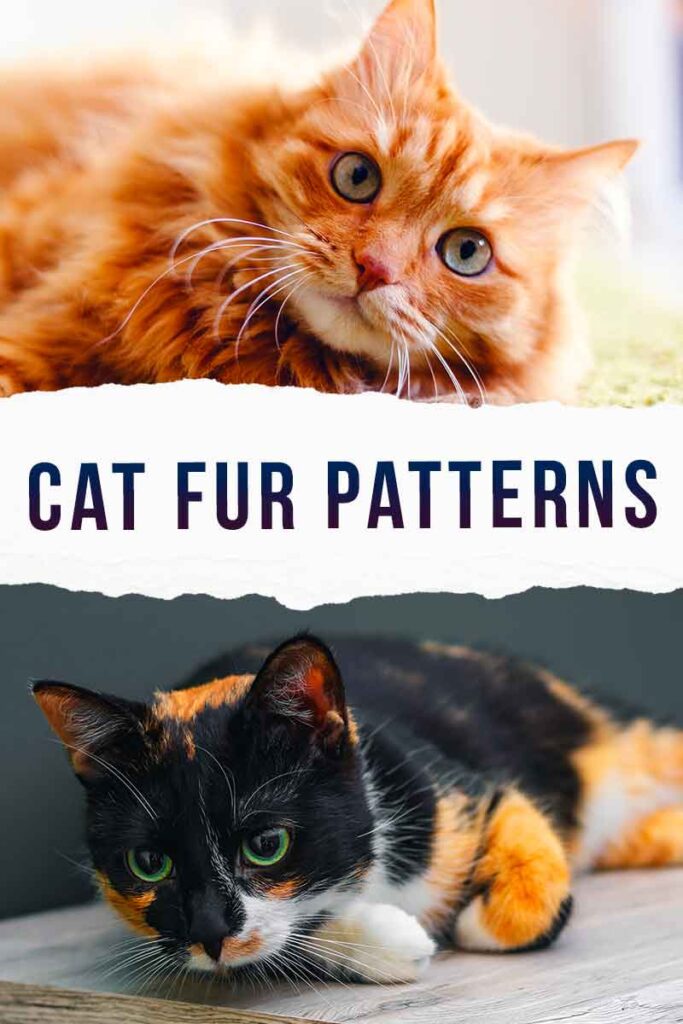
In this quick primer to cat fur patterns, we take a look at the most common markings on cats, and a few of the most notable unusual patterns too.
Almost all of the cat fur patterns seen on pet cats today are the result of human selection for genetic mutations which originated as a one-off. Our love of cats means that breeders have been able to develop and maintain nearly countless distinct types of patterns and markings.
Cat fur patterns
Cats have come a long way since their wild days. Domestic cats’ wild ancestors all had tabby coat patterns – ideal for making themselves hard to spot in long grasses and tall vegetation. In the wild, genetic mutations which caused cat fur patterns very different from this also reduced the chances of surviving long enough to produce kittens. For example by making them more visible to predators. But since domesticating cats started around 10,000 years ago, kittens born with new and unusual fur patterns have been prized and looked after by humans. Now, there are dozens of unique observable cat fur patterns.
In this article we’re going to look at some of the best known types of cat fur patterns, and some pretty unique and unusual ones. How many have you seen on a real life cat?

Types Of Cat Fur Patterns
If you like, you can use these links to navigate the types of cat fur pattern more quickly.
- Solid coats
- Tabby patterns
- Tortoiseshell cats, including Torbies
- Bicolor cats
- Calico cats, including Torbicos
- Colorpoint cats
- Unusual cat fur patterns
Let’s start with the pattern which doesn’t really look much like a pattern at all.
Solid Coats
Solid cat coats are defined by their lack of pattern. In other words, solid coats are one color all over. Be it black, white, gray, brown, fawn, or cream. Interestingly, there is no such thing as a true solid red or ginger cat. Genetically, all red cats (whether dark red, vibrant ginger or soft apricot) are also tabby patterned. But, some red cats have such low color contrast between their stripes that they look as good as solid colored.
Tabby Coats
Tabby stripes were the original coat pattern for domestic cats. We’ve already touched on what made this pattern so beneficial for survival. But did you know there are actually several types of tabby pattern, which are all genetically distinct from one another?
Mackerel
Mackerel tabbies have slender, broken or unbroken stripes. There are many possible colors for the stripes and their background colors, from black-on-grey to red-on-gold, via a spectrum of chocolatey browns and sophisticated silvers.
Blotched
Blotched tabby cats are also known as classic tabby cats. Their stripes are arranged around a prominent ‘bullseye’ on each side of their abdomen.
Spotted
When a tabby cat’s stripes are broken into fragments, they look like spots instead. Lots of cat breeds can have a spotted tabby pattern. But it is most closely associated with Egyptian Maus and Savannahs, which aren’t accepted for show in any other patterns at all.
Ticked
Ticking is when each strand of hair has distinct bands of color along its shaft. This pattern is synonymous with the Abyssinian cat breed. It’s not a pattern you might immediately associate with being tabby, but genetically it is a type of tabby pattern, and the visible giveaway is the shaded ‘M’ on their forehead.
Unusual tabby patterns
Besides the four most commonly seen types of tabby pattern, there are also a variety of unusual tabby patterns. For example Toyger cats have a modified mackerel pattern which is bolder, straighter, and more uniformly vertical than the traditional mackerel tabby pattern.
Tortoiseshell Cats
Tortoiseshell cats have patches of red-based pigment and black-based pigment in their fur. The colors in the patches may be densely pigmented, diluted or modified. For example light orange and brown patches, or cream and blue patches. The patches can be small and densely packed (sometimes known as brindled) or larger and more distinct. Each of Tortie cat’s patches can also contain visible tabby stripes – this is know as a torbie pattern. Owing to the way cat fur patterns and colors are inherited, tortoiseshell cats are almost invariably female.
Bicolor Cat Fur Patterns, aka. White Spotting
Bicolor cats have solid, tabby, or tortoiseshell coats with white patches – ‘bicolor’ is shorthand for ‘white and something else’. The white patches can be as small as a single locket mark on their chest, or cover nearly the entire body. The white patches spread across a cat’s body in a fairly predictable way whilst they are still in the womb, and are usually quite symmetrical (but not necessarily perfectly so). Tuxedo markings are a type of bicolor cat fur pattern. In the United States, tortoiseshell cats with white patches are also known as calico cats.
Calico Cats
Calico cats have patches of black pigmented fur, red pigmented fur and white fur. Genetically they are expressing both the tortoiseshell coat pattern and the bicolor pattern. The larger the white patches on a calico cat, the larger and more distinct each red-based and black-based patch is too. If the tortoiseshell areas in their coat also have perceptible tabby stripes inside the patches, they also also called torbico patterned.
Like tortoiseshell cats, the vast majority of calico cats are female.
Colorpoint Cat Patterns
The most famous breed with colorpoint markings is the Siamese. But they’re also a trademark of
- Burmese
- Tonkinese
- Birman
- Himalayan
- Ragdoll
- and Colorpoint Shorthair cats.
Colorpoint patterns are caused by an amazing genetic mutation, which makes pigment production temperature sensitive. So colorpoint cats only produce pigment where their skin surface temperature is lowest. Since the colorpoint pattern is genetically distinct from tabby and tortoiseshell patterning, it’s possible for cats to inherit two, or even all three! When they inherit all three, their body is pale and unpigmented, but their muzzle, ears, legs and tail have tortie patterning with tabby stripes visible in each patch. This smorgasbord of patterns is also called ‘lynx’ patterning.
Unusual Cat Fur Patterns
Finally, we have a round up of some unusual cat fur patterns. Some of them are unique to specific breeds and not generally seen throughout the cat population at large. Others are even less predictable!
Rosettes
Rosettes are a pattern of broken irregular circles. Usually the broken outline of the circle is darkest, the background is lightest, and the center of the circle has a medium tone. Rosettes are most closely associated with Bengal cats, who inherited them from their Asian leopard cat ancestors.
Snow shoes
Snow shoe markings are the result of expressing both a colorpoint pattern and white bicolor markings. They can appear on lots of breeds, but they disqualify the traditional colorpoint cats from breed shows, so breeders tend to avoid them. However, the Snowshoe cat breed is a celebration of cats with both patterns.
Grizzle and shimmer patterns
Both the grizzle and shimmer patterns are characterized by each individual hair having a band of much lighter color at the tip. Grizzle patterned cats have black hairs with light-colored tips. This pattern is seen in wild jungle cats, and the Chausie domestic cat breed, which has wild jungle cat heritage. Shimmer patterned cats have gray coats with white or translucent tips. This pattern is seen in the Russian Blue and Korat cat breeds.
Van
The van cat fur pattern is a modified form of the bicolor pattern. It’s named after the Turkish Van cat breed, which always has a van pattern coat. Van patterned cats have a white body and legs, but their tail is pigmented, and they have a pigmented ‘cap’ on top of their head, which includes their ears.
Chimera
Chimera cat fur patterns occur when two embryos fuse together in the womb at a very early stage, and continue to develop as one single kitten (a chimera). Since the coat pattern of each embryo will have already been genetically determined, the new chimera kitten will have patches of each pattern in its coat.
Cat Fur Patterns – Summary
Humans have captured and replicated a huge variety of different cat coat patterns and colors. Some of them began as a single genetic mutation. Others were introduced by breeding pet cats with wild cat breeds. We hope you’ve enjoyed learning a bit more about them!
What pattern does your cat have?
Which coat pattern does your kitty have? Do you have a favorite pattern you particularly admire? Let us know in the comments box down below.
You might also enjoy
- Cat Colors – Unravelling The Secrets Of Cats’ Beautiful Coats
- Tuxedo Cats – 38 Awesome Facts You’ll Love
- Mackerel Tabby – Is The Original Cat Coat Pattern Also The Best?
- Spotted Tabby Cats – Which Breeds To Look For And What To Expect
- Tortoiseshell Cat: Over 33 Fascinating Facts About Tortie Cats
- Calico Cat Facts: 25 Amazing Facts About Calico Cats
References
Kaelin & Barsh. Genetics of Pigmentation in Dogs and Cats. Annual Review of Animal Biosciences. 2013.
Lyons et al. The Tabby cat locus maps to feline chromosome B1. Animal Genetics. 2006.
Lyons et al. Tyrosinase mutations associated with Siamese and Burmese patterns in the domestic cat. Animal Genetics. 2005.
Leave a Reply